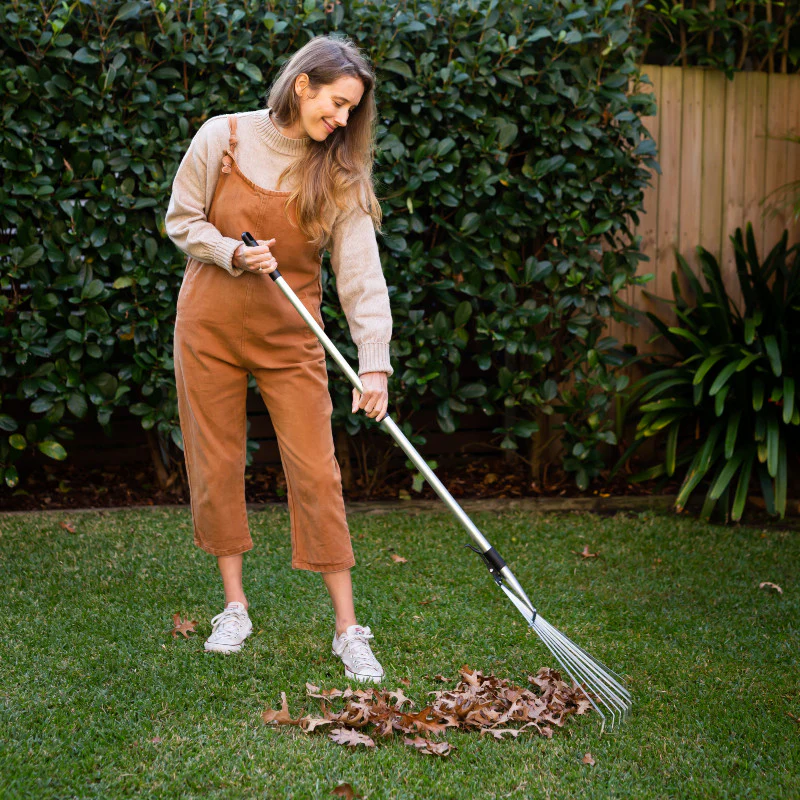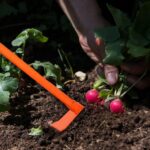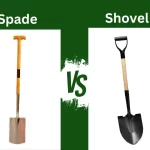A garden rake is a versatile tool essential for maintaining a well-groomed and healthy garden. It is a long-handled implement with a sturdy head featuring a row of short, rigid tines or prongs. The primary purpose of a garden rake is to gather, collect, and remove debris such as leaves, twigs, and other organic matter from lawns, flower beds, and garden paths.
Garden rakes come in various types, each designed for specific tasks. The most common types include:
- Leaf Rake: Featuring a wide, fan-shaped head with flexible tines, a leaf rake is ideal for gathering and piling leaves, grass clippings, and lightweight debris. Its design allows for efficient raking over large areas.
- Shrub Rake: With a shorter and more compact head, a shrub rake is perfect for working around bushes, shrubs, and tight spaces. Its sturdy tines can dislodge stubborn debris and cultivate soil in confined areas.
- Thatch Rake: Designed with rigid, sharp tines, a thatch rake is used to remove the buildup of dead grass, roots, and other organic matter from lawns, a process known as dethatching. This tool helps improve air circulation and water penetration in the soil.
- Bow Rake: Featuring a curved, bow-shaped head with short, sturdy tines, a bow rake is versatile for leveling soil, spreading mulch, and creating furrows for planting seeds or transplanting seedlings.
- Landscape Rake: With a broad, flat head and sturdy tines, a landscape rake is ideal for leveling and smoothing larger areas, such as preparing soil for sod installation or creating a level surface for patios or walkways.
Table of Contents
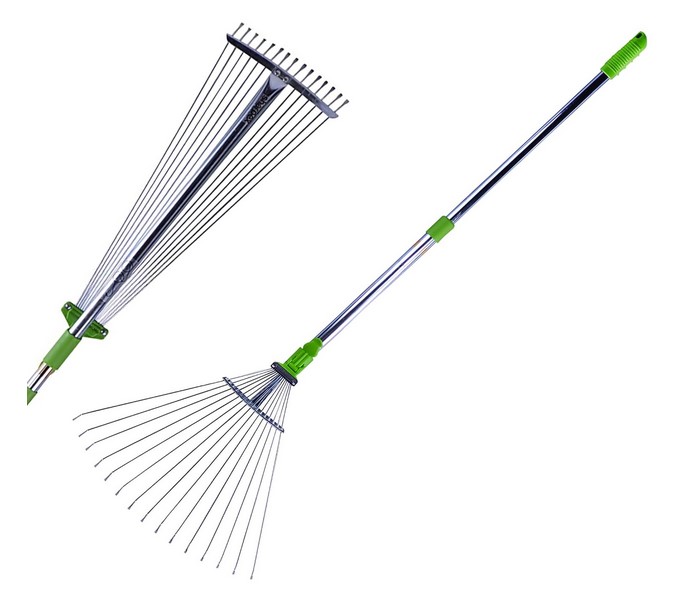
Benefits of Using a Garden Rake
A garden rake is an invaluable tool that offers numerous benefits to gardeners and lawn enthusiasts. One of the primary advantages is the ease with which it allows you to accomplish various gardening tasks. With its sturdy tines and ergonomic design, a rake streamlines activities like dethatching, leveling soil, and removing debris, reducing physical strain and saving time.
Another significant benefit of using a garden rake is improved soil aeration. As you rake the soil, you create small channels and loosen compacted earth, allowing air to circulate more freely. This increased aeration promotes healthy root growth and facilitates better water and nutrient absorption for your plants.
Raking is also an effective method for removing debris and weeds from your garden or lawn. The tines of the rake can easily collect fallen leaves, twigs, and other organic matter, keeping your outdoor spaces tidy and well-maintained. Additionally, raking can help uproot shallow-rooted weeds, preventing them from spreading and competing with your desired plants for resources.
Moreover, a garden rake plays a crucial role in leveling the soil surface. Whether you’re preparing a seedbed, smoothing out uneven areas, or creating a uniform finish after tilling, a rake ensures an even and consistent soil texture. This not only enhances the aesthetic appeal of your garden but also facilitates better seed germination and plant growth.
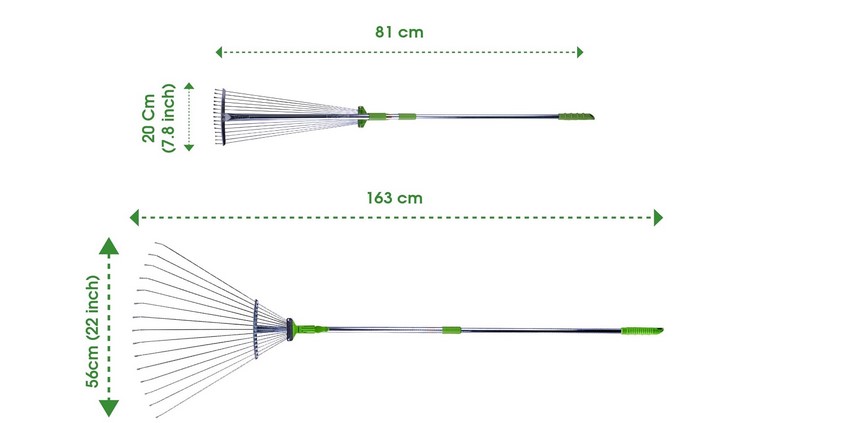
Choosing the Right Garden Rake
Selecting the appropriate garden rake is crucial for efficient and comfortable gardening tasks. There are several factors to consider when choosing the right rake, including size, material, tine spacing, rake head shape, and handle length and material.
Factors to Consider:
- Size: Garden rakes come in various sizes, from compact models for small spaces to larger rakes for extensive areas. Consider the size of your garden and the tasks you’ll be performing to ensure you have the right tool for the job.
- Material: Rakes are typically made from different materials, such as steel, aluminum, or plastic. Steel rakes are durable and long-lasting but can be heavy, while aluminum rakes are lightweight and rust-resistant. Plastic rakes are lightweight and affordable but may not be as durable as metal options.
- Tine Spacing: The spacing between the tines (teeth) on the rake head is important for different tasks. Wider spacing is better for raking up larger debris like leaves and twigs, while narrower spacing is ideal for cultivating soil and removing smaller particles.
Rake Head Shapes:
- Fan Rake: This rake features a broad, curved head with tines arranged in a fan-like pattern. It’s excellent for raking up leaves, grass clippings, and other lightweight debris.
- Shrub Rake: With a shorter, more compact head and tines, a shrub rake is designed for working around bushes, trees, and tight spaces.
- Level Head Rake: This rake has a straight, level head with tines arranged in a row. It’s ideal for leveling and smoothing soil, as well as removing debris from flat surfaces.
- Bow Rake: Featuring a curved head and tines, a bow rake is versatile and can be used for raking up debris, cultivating soil, and creating furrows or trenches.
Handle Lengths and Materials:
- Length: Rake handles typically range from 48 inches to 66 inches or longer. Shorter handles are better for working in tight spaces or when kneeling, while longer handles provide more leverage and reduce back strain for taller individuals.
- Materials: Common handle materials include wood, fiberglass, and metal. Wooden handles offer a classic look and comfortable grip but can be heavier. Fiberglass and metal handles are lightweight and durable but may not be as comfortable for extended use.
When selecting a garden rake, consider your specific needs, the tasks you’ll be performing, and your personal preferences for comfort and ease of use.
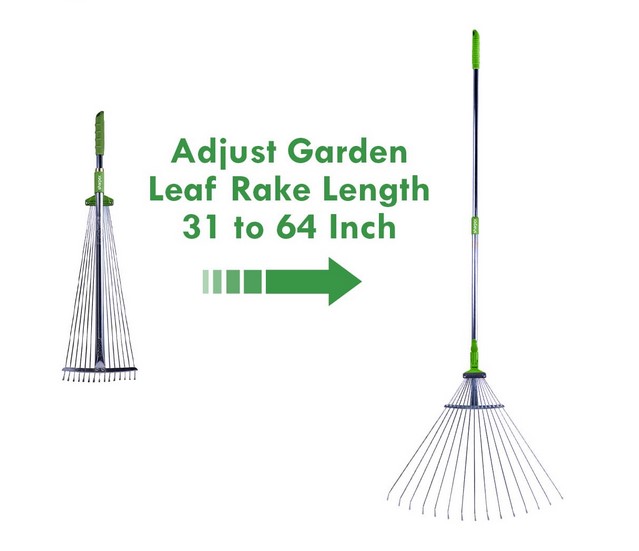
Proper Raking Techniques
Proper raking techniques are essential for efficient gardening and preventing strain or injury. Before you begin raking, prepare the area by removing any large debris or obstacles that could impede your raking motion. Clear the area of rocks, sticks, or other objects that could potentially damage your rake.
When positioning your rake, maintain a shoulder-width stance with your feet slightly apart for better balance and stability. Bend at the knees and keep your back straight to avoid unnecessary strain. Hold the rake handle with both hands, one hand near the top and the other towards the middle, allowing for a comfortable grip and control.
Employ different raking patterns depending on the task at hand. For general raking, use a back-and-forth motion, overlapping each stroke slightly. For more thorough raking, such as when removing thatch or loosening soil, use a more vigorous up-and-down motion, lifting the rake tines slightly off the ground with each stroke.
When raking, engage your core muscles and use your legs to generate the raking motion, rather than relying solely on your arms and back. This ergonomic technique will help prevent fatigue and reduce the risk of injury. Periodically switch the hand positions on the rake handle to distribute the workload evenly across your arms and shoulders.
Raking for Different Garden Tasks
Raking for Soil Preparation: Raking is an essential step in preparing garden beds for planting. Use a sturdy bow rake or flat-tine rake to break up and loosen compacted soil. This allows air and water to penetrate, creating an ideal environment for root growth. Rake the soil in overlapping rows, working the tines into the earth to cultivate the top few inches.
Leaf Removal: A leaf rake is the ideal tool for gathering fallen leaves from lawns and garden beds. Its fan-like shape and flexible tines make it easy to rake leaves into piles for disposal or composting. Work in sections, raking with short strokes to gather the leaves efficiently. Be sure to rake against edges and borders to remove leaves from hard-to-reach areas.
Thatch Removal: Thatch is the layer of dead grass and roots that accumulates on lawns over time. If left unchecked, it can prevent water and nutrients from reaching the soil. Use a specialized thatch rake or dethatching rake with sharp, rigid tines to remove this layer. Rake vigorously in overlapping rows, catching the loosened thatch for disposal.
Leveling Soil: After tilling or cultivating garden beds, use a flat-headed rake to level and smooth the soil surface. This creates an even planting area and helps prevent water from pooling in low spots. Work the rake back and forth in gentle strokes, spreading and leveling the soil evenly. Pay special attention to edges and corners for a neat, uniform appearance.
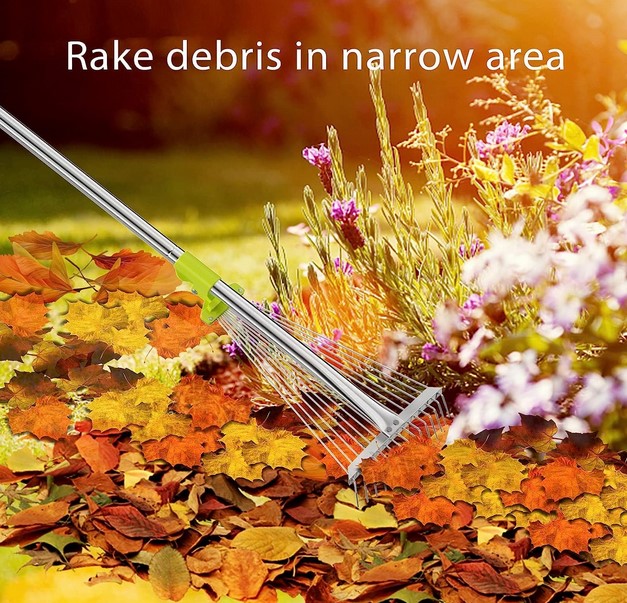
Maintaining Your Garden Rake
Proper maintenance is essential to ensure your garden rake remains in top condition and lasts for years to come. Here are some key tips for maintaining your rake:
Cleaning the Rake
After each use, remove any debris, soil, or plant matter stuck in the tines or head of the rake. Use a stiff brush or your hands to dislodge stubborn materials. Rinse the rake with a garden hose to remove any remaining dirt or debris. Allow the rake to dry completely before storing.
Storing the Rake Properly
Avoid leaving your rake outdoors, as exposure to the elements can cause premature rusting or deterioration. Store your rake in a dry, sheltered area, such as a shed or garage. If hanging the rake, ensure the tines are facing down to prevent bending or warping.
Signs of Wear and Replacement
Over time, even with proper care, your garden rake will show signs of wear and tear. Watch for bent or broken tines, as these can make raking less effective and potentially damage your lawn or garden. If the rake head becomes loose or separates from the handle, it’s time to replace the rake. Additionally, if the handle develops cracks or splinters, consider investing in a new rake for safety and ease of use.
Raking Tips and Tricks
Time-saving Tips
- Rake while the soil is slightly damp, not soaked or completely dry, to make the task easier.
- Work in sections, dividing your garden into manageable areas for efficient raking.
- Use a lightweight, ergonomic rake to reduce strain and fatigue.
- Invest in a rake with a longer handle to minimize bending and back strain.
Techniques for Different Soil Types
- For loose, sandy soil, use a rake with flexible tines to avoid displacing too much soil.
- For heavy, clay-rich soil, choose a sturdy rake with rigid tines to break up compacted clumps.
- In rocky or root-filled areas, opt for a rake with widely-spaced tines to avoid snagging.
- For delicate seedbeds or established lawns, use a leaf rake with gentle, flexible tines.
Using Rake Attachments
- Add a thatch removal attachment to your rake for efficient removal of built-up debris from lawns.
- Attach a cultivator to your rake for breaking up and aerating soil before planting.
- Use a rake with a built-in level for creating perfectly even seed beds or graded paths.
- Consider a rake with a detachable handle for easy storage and transport.
Garden Rake Safety
Raking may seem like a simple and harmless gardening task, but it can lead to injuries if not done properly. Maintaining the correct posture, avoiding strain, and using protective gear are essential for safe raking.
Proper Raking Posture
Posture is crucial when raking to prevent back pain and strain. Stand with your feet shoulder-width apart, knees slightly bent, and keep your back straight. Avoid bending from the waist as much as possible. Instead, bend your knees and use your leg muscles to do the work. Switch sides frequently to distribute the effort evenly.
Avoiding Strain Injuries
Raking can be physically demanding, especially when working with large areas or heavy debris. To avoid strain injuries, take frequent breaks and switch between raking and other gardening tasks. Use proper lifting techniques when moving piles of leaves or debris, bending your knees and keeping your back straight.
Protective Gear
Wearing the right protective gear can help prevent injuries and ensure your safety while raking. Sturdy, closed-toe shoes with good traction are essential to avoid slips and falls. Gloves can protect your hands from blisters and scratches. If working in dusty conditions, consider wearing a face mask or respirator to prevent inhaling particles.
Eco-Friendly Raking Options
For gardeners committed to sustainable practices, there are several eco-friendly options when it comes to raking. One approach is to choose rakes made from renewable or recycled materials, such as bamboo or repurposed plastic. These rakes have a lower environmental impact compared to traditional metal or wooden rakes.
Another eco-friendly option is to opt for hand rakes over gas-powered or electric rakes. While power rakes may be more efficient for large areas, hand raking is a low-impact, emission-free alternative that also provides a gentle form of exercise.
Additionally, composting the materials collected during raking is an excellent way to divert organic waste from landfills and create nutrient-rich soil amendments for your garden. Leaves, grass clippings, and other plant debris can be easily composted, reducing waste and returning valuable nutrients to the earth.
Raking in Different Garden Styles
Vegetable Gardens: Proper raking is essential in vegetable gardens to prepare the soil for planting and maintain healthy growth. Rake the soil gently to remove debris and level the surface before sowing seeds or transplanting seedlings. Avoid raking too deeply, as it can disturb the soil structure and damage plant roots.
Flower Gardens: In flower gardens, raking serves multiple purposes. It helps remove dead leaves, fallen petals, and other organic matter, keeping the garden tidy and preventing the buildup of thatch. Rake gently around delicate plants to avoid damaging them. Additionally, raking can help incorporate fertilizers or soil amendments into the topsoil.
Japanese Gardens: Raking plays a crucial role in the creation and maintenance of Japanese gardens. The art of raking sand or gravel into intricate patterns, known as “suna-tsuchi,” is an integral part of Japanese garden design. Skilled gardeners use specialized rakes to create mesmerizing patterns that symbolize the natural elements and promote a sense of tranquility.
Low-Maintenance Gardens: For low-maintenance gardens, raking can be a time-saving and efficient task. Regular raking helps remove fallen leaves, twigs, and other debris, preventing the buildup of organic matter that can harbor pests and diseases. Additionally, raking can help aerate the soil, promoting better water and nutrient absorption for your plants.

